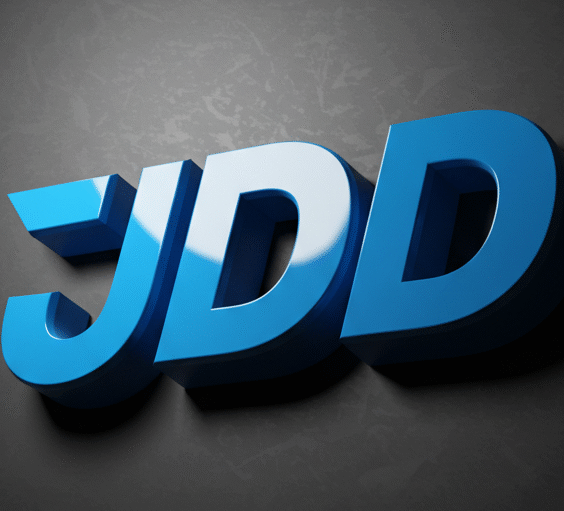Trump and the LA Protests: 2025, the Repeated Clash of 'Law and Order' and a Forgotten Past
June 2025, LA is hot again. This time, the streets are filled with protests against the crackdown on illegal immigrants, and with former President Donald Trump ordering the National Guard to be deployed, tensions are high. At first glance, doesn’t it remind you of the protests following the death of George Floyd in 2020? Trump’s image of deploying public power while shouting “law and order,” and the chaos that enveloped LA.
But the history of conflicts between public power and social conflict in LA is much deeper. What did American society learn and change in the midst of the pain of the 1992 LA riots that turned Koreatown into ashes? In this article, we will focus on the current LA protests in 2025, connect the shadows of 2020 with the lessons of 1992, and explore the complex reality facing 'law and order' in America, and the essence of the social conflicts that repeat within it.
Going back and forth between the past and present, it is time to think about the true face of America that LA holds and the challenges of the future.
index
1. LA 2025, the beginning of a rekindled protest
Now, in June 2025, LA is once again going through a turbulent time. Before the pain of the past can be forgotten, a new spark is heating up the city. Everywhere on the streets, Strengthening crackdown on illegal immigrantsThe voices of citizens protesting are ringing out loud. The protests that started with peaceful cries sometimes mix with excitement and conflict, reaching a peak of tension. From desperate appeals to violent confrontations, the situation in LA, which is expressed in various ways, brings about a familiar anxiety and deep concern. Citizens are expressing their frustrations about forced separations at the border, the rapidly increasing deportation orders, and the uncertain future of immigrants. The voices of anxiety and resistance are growing, especially among the Latino community that has long been rooted in LA. The air in LA is filled with cries that their lives and survival are directly threatened. Some protests are taking the form of blocking traffic or blocking access to public facilities, which is causing fatigue and controversy throughout society. This movement is not just an immigrant issue, but is raising questions about human rights and justice that form the foundation of American society.
What has added fuel to this confusion is none other than Donald Trump He is the president. He is trying to suppress the protests. 2,000 National Guard troops deployedHe sent a consistently strong message, ordering a heavy rain. His appearance, which has been shouting “Law and Order” countless times, is once again making headlines around the world. While his supporters may see him as “reassuring the chaos with his strong determination, as expected from Trump,” his opponents are raising sharp concerns, saying, “Isn’t he repeating past mistakes?” and “Isn’t he abusing his power to make the situation worse?” In some areas of downtown LA, physical clashes between police and protesters have already been reported in the past few days, and the announcement of the deployment of the National Guard is further heightening the tension. Local media are analyzing that Trump’s decision could provoke protesters’ backlash and deepen social division rather than calming the situation. Even the responses of the LA city government and the California state government are mixed, showing signs of developing into a conflict between the federal and state governments.
Here we feel a familiar sense of 'déjà vu', because just a few years ago, in 2020, LA was enveloped in a similar shadow of chaos. George Floyd's death[Learn more about the George Floyd case]The large-scale protests triggered by the incident engulfed the entire United States, exploding deep-rooted anger against racial discrimination, and LA was no exception. At that time, the Trump administration emphasized the absolute superiority of public power by deploying the National Guard in the name of “law and order.” Of course, the “themes” of the protests are different. At that time, it was deep anger against racial discrimination, and now it is a backlash against immigration policy. However, the two incidents strangely overlap in that they took place in the same space called LA and the government’s strong “intervention of public power,” and they make us think again about the chronic conflict patterns in American society.
So are the current LA protests of 2025 simply a new incident, or is it another form of deep social conflict in the United States? It raises questions about how these protests differ from the experience of 2020, and what historical roots they have. In this article, we will analyze the current protests in LA, Trump’s past responses, and even the painful history of the United States, the 1992 LA riots, by going beyond a simple list of events and finding a complex social context and lessons we must learn. It is time to deeply explore how all of this historical context is shaping the present of LA in 2025.
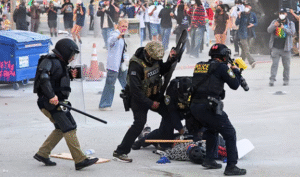
2. Shadow of 2020: The Return of ‘Law and Order’
When we talk about the LA protests of 2025, we naturally think of the summer of 2020. The shocking events that took place in Minneapolis, USA, in May of that year, George Floyd's deathThe deep-rooted anger against racial discrimination in the United States exploded. The cry of 'Black Lives Matter' resonated across borders and around the world, and LA was also swept into the huge wave of protests. What started out as peaceful protests turned into chaos in some areas, with looting and arson. The spread of these protests went beyond the death of an individual, revealing deep dissatisfaction with the structural inequality and racial conflict throughout American society.
Coincidentally, Donald Trump, who was also president at the time, defined the situation as a “riot.” 'Law and Order'He strongly urged governors to take a hard line to suppress the protests, and eventually called for a federal government crackdown. Deploying the National Guard[Learn about the role of the National Guard]The Trump administration’s position was clear: “We will not stand by and watch as lawlessness becomes a reality.” His supporters cheered his strong leadership in calming the chaos, but he faced strong criticism from the other side that he was suppressing freedom of expression and provoking protesters. There were also many who pointed out that the mobilization of military force actually heightened tensions and increased public opposition. During this period, Trump’s “law and order” frame also became an important means of solidifying his political base.
Just five years later, the protests taking place in LA in 2025 are different in theme (racism vs. immigration crackdown), but they are also about Trump's use of public power. It's a chilling re-enactment of the situation in 2020.. In 2020, there were mixed reviews on how effective the deployment of the National Guard was in suppressing protests or whether it only increased the controversy. However, Trump seems to firmly believe in this method as his ‘problem-solving formula.’ LA protestsis burning again, and in the background TrumpIt is no coincidence that the 'hardline policy' of the government is emerging. It raises fundamental questions about the conflicts deep in American society and the role of public power. Will the National Guard, in the name of 'law and order', be able to calm the chaos in LA this time, or will it only leave behind more controversy and wounds?
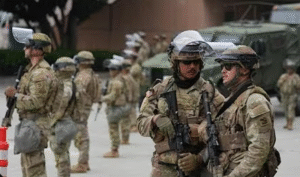
3. The Scars of the 1992 LA Riots: Deep Historical Context
When we talk about the LA protests of 2020 and 2025, we cannot ignore the city’s much deeper historical wounds. 1992 LA Riots[1992 LA Riots Overview], also known as the '4.29 Incident'. This incident occurred in March 1991, when a black man Rodney KingIt all started when a shocking video of a man being brutally beaten by white police officers was released. At the time, citizens were outraged by the obvious police brutality and expected justice. However, on April 29, 1992, the following year, when the officers involved were found not guilty, the explosive anger spread throughout LA in an instant, and the city was literally reduced to ashes with looting, arson, and violence for three days and nights. This riot was not simply a protest against 'police brutality', but an escalation of decades of Racial discrimination, wealth gap, social inequalityIt was the result of a series of deep-rooted problems in the United States erupting at once: the long-standing alienation of the black community, distrust of the system, and economic frustration.
One of the communities that was particularly hard hit by these riots was LA Koreatown During the height of the riots, the police mainly protected black and white neighborhoods and failed to effectively intervene in areas where Korean stores were concentrated. As a result, many Korean stores were defenselessly targeted by looting and arson. The sight of Koreans taking up arms and protecting their stores to survive was reported by media outlets around the world and caused great shock. This was a tragic cross-section of the complex racial relations and tensions between ethnic minorities in American society at the time. This painful history not only left deep wounds and trauma in the Korean community, but also brought to the surface the complex relationships and lack of mutual understanding between ethnic minorities in the United States. After the riots, American society began to seriously consider race relations, police reform, and the need for urban regeneration, but the wounds still remain. For many, 1992 is remembered not simply as an event of the past, but as a symbol of social instability that could flare up again at any time.
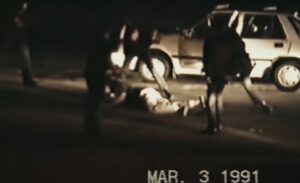
The 1992 LA riots had different direct causes than the protests in 2020 and 2025, but A strong warning that social exclusion and inadequate or excessive responses by public authorities could lead to large-scale chaos.The riots at the time vividly showed what can happen when the government fails to properly listen to the grievances and suffering of citizens, and when the judicial system fails to deliver justice. The protests in 2020 were about anger at the inadequate response of public authorities to racism, and the protests in 2025 were about resistance to policies that oppress the lives of immigrants. LA exploded for different reasons at each of these three points in time, but they had one thing in common: The role of public power, the human rights of minorities, and the system's attitude toward the socially disadvantagedIt raises a key question: how do past wounds connect to present anxiety? We need to think seriously about what lessons we can learn from this recurring pattern.
4. In-Depth Analysis of the 2025 Protests: Immigration Policy and America’s Conflicts
Now, let’s go back to LA in 2025 and take a closer look at the ongoing protests. The biggest spark of these protests is none other than Former President Trump's strong immigration policyIt is. With his slogan of “America First,” border wall construction, large-scale deportation of illegal immigrants, and reduction in legal immigration, his immigration policies have always been at the center of controversy. The protests, which were reignited in 2025, erupted as signs of a more aggressive immigration crackdown by the Trump administration (or future Trump administrations) began to appear. In particular, the fear that if his policies are strengthened, the foundations of the lives of immigrants who have lived in the United States for decades could be shaken to their core has become the fuse of the protests. The protesters claim that these policies are not simply “law enforcement,” but are tearing apart the lives of countless immigrant families and violating basic human rights. This is a cry that we must approach the issue of human suffering and tragedy beyond the simple act of crossing the border.
The voices echoing through the streets of LA today go beyond simply opposing deportation. Immigrants are complaining about complex issues such as economic hardship due to their unstable status, limited access to social services, and psychological discouragement. In particular, the Latino community that has long lived in LA is most directly affected by these policy changes, and they feel that their cultural identity and the existence of their community are threatened. Since LA is a representative city with a large immigrant population and diverse cultures in the United States, these changes in immigration policy have a profound impact on the social structure and dynamics of the entire city. Deploying the National GuardTrump’s decision could further heighten the protesters’ discontent and deepen their confrontation with the authorities. We have already experienced in the past that such hard-line measures have rather strengthened the solidarity of the protesters and deepened social divisions. The deployment of the National Guard this week risks inciting fear in the immigrant community and sharpening the confrontational structure of “us versus you.”
This section will delve deeper into the complexity of the immigration issue, which is the central issue of the current protests, and the impact of the Trump administration’s (or future Trump administration’s) approach to it on American society. Immigrant communities are making their voices heard, human rights groups are making their voices heard, and politicians are making their political calculations heard. In particular, this issue is a sensitive issue that goes beyond simply securing the border, as it directly affects America’s identity, labor market, and future demographics. The protests are a major challenge for the United States. Racial Composition and Social IntegrationIt will be an opportunity to think together about how the deep concerns and conflicts surrounding immigration issues in American society are being expressed and what the ultimate outcome of these conflicts will be, while highlighting the long-term impacts that these protests will have on American society. Based on the lessons of the past, we must not ignore the message that these protests are sending to American society.

5. America's Challenges and Future in Repeated Conflicts
From the 1992 LA riots to the 2020 George Floyd protests and the current immigration protests of 2025, LA has been the scene of social upheaval large and small for decades. These events cannot be simply dismissed as a few protests or riots, but as something deeply rooted in the heart of America. Conflicts between race, immigration, and classclass The role of public powerIt raises a fundamental question. In particular, it is still controversial whether the Trump-style solution that emphasizes 'law and order' can fundamentally resolve this social discontent. History has repeatedly shown that a strong suppression may bring short-term stability, but if it fails to resolve the fundamental social discontent, it will eventually explode in another form.
The current LA protests are a reminder of the challenges facing the United States, including whether we have properly learned the lessons of the past and how we will address social minority issues, including immigration. With the possibility of Trump’s re-election, his immigration policies could be strengthened, which would bring about profound changes in the racial and cultural landscape of American society. What direction should American society take amidst repeated conflicts? It is time to seriously consider the future of public power, civil rights, and a multicultural society where people of various races and backgrounds live together. Immigration has been a key driving force in American history, but it has also always been a source of conflict. We urgently need balanced policies that respect the contributions and human rights of immigrants while also achieving social consensus.
In conclusion, the repeated protests and clashes between public authorities in LA symbolize the homework that American society has yet to solve. If there is no effort to remove the seeds of fundamental conflict through social dialogue, understanding, and institutional reform beyond mere physical suppression, LA may continue to be a place of turmoil in the future. I hope that this 2025 protest will be a turning point for looking back on the pain of the past and for true integration and harmony in American society. How do you view all of this situation?
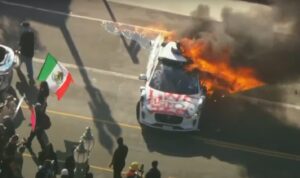
summation
- LA protests 2025The situation is escalating with Trump's order to deploy the National Guard, which is a 2020 George Floyd Protests It reminds me of Trump's hard-line stance at the time.
- This method of public power intervention 1992 LA RiotsIt shows America's deep-rooted history of race, immigration, and class conflicts that stretch back to the 19th century.
- In all three periods, LA was a site of social upheaval that raised fundamental questions about the role of public authority and the rights of minorities.
- Trump’s “law and order” solution may bring short-term stability, but it suggests that conflict may recur unless it addresses fundamental social problems.
- Ultimately, American society faces the important task of learning from the lessons of the past to create a future of true unity and harmony.
* US student visa suspension, embassy shutdown..article Go see
